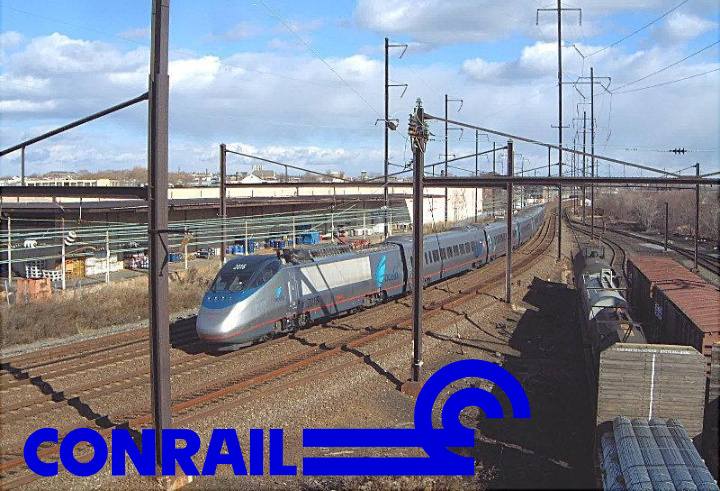



Freight Trains on Passenger Railroads Ronald L. Batory President and Chief Operating Officer Consolidated Rail Corporation 2
Freight Trains on Passenger Railroads Conrail’s Experience 3
Understanding the past can facilitate the molding of a better future Significant event chronology Event impact on Conrail Concurrent opportunities evolving from rail freight and passenger growth 4
Events of the 1970’s set the stage for freight railroads to gradually divest themselves of passenger train operations Pre-1971 • Penn Central and other Conrail predecessor railroads provided all inter-city and most commuter rail passenger services 1971 • Amtrak assumes responsibility for intercity passenger service 1971-72 • New York-MTA and Connecticut-DOT purchase/lease Penn Central commuter lines 1976 • Conrail begins operations – including commuter train service in 6 cities • Amtrak assumes control of operations on Northeast Corridor • Commuter agencies can acquire “3R Act” designated lines under “900 Day Option” 5
Transfer of intercity and commuter rail operations matured considerably between 1977 - 1986 1977 • MBTA selects Boston & Maine to operate Boston “South Side” commuter trains 1981 • NERSA authorizes the divestiture of commuter train service by end of 1982 1983 • Train crews on Northeast Corridor become Amtrak employees • Commuter agencies begin “independent” operation of commuter services 1986 • Train crews on “Off Corridor” Amtrak trains become Amtrak employees 6
Freight train presence and associated operations changed considerably throughout the 1980’s and early 1990’s 1980’s • Conrail gradually reroutes most through freight trains off Amtrak controlled lines 1984 • Conrail obtains trackage rights on CSX between Philadelphia and Washington 1987 • Amtrak institutes “Time of Day” and speed restrictions for freight trains on Northeast Corridor 1988 • Rail Safety Act of 1988 requires LSL equipment on all Northeast Corridor trains by April 1990 1992 • Baltimore MTA Light Rail Line begins “Time Separated” operation • VRE-Virginia Railway Express starts commuter train service from Washington 7
Post Split Conrail evolves into another era of change 1999 • Conrail Shared Assets begins operations in 3 terminal areas 2000 • New Jersey Transit expands train frequency and station presence 2001 • Amtrak expands train frequency with some higher track speeds 2004 • Southern New Jersey Light Rail Line begins “Time Separated” operation 8
SEPTA Current passenger line partners 9
a Percent of miles interfacing with passenger trains has not changed significantly during Conrail’s history… FACTS 1976 1999 2005 Interface Freight/Passenger Miles 4,928 2,805 181 Total Conrail Route Miles 19,222 10,826 762 Percent of Interface Miles 26% 26% 24% vs. Total Route Miles 10
a …although passenger trains per mile of interface has risen more than tenfold as a result of capacity density changes… FACTS 1976 1999 2005 Interface Freight/Passenger Miles 4,928 2,805 181 Total Interface Passenger Trains 2,211 2,345 768 Number of Interface Passenger 0.4 0.8 4.2 Trains per Mile 11
a …while interface passenger trains per passenger route on Conrail’s network has grown 73.6% since its inception. FACTS 1976 1999 2005 Total Interface Passenger Trains 2,211 2,345 768 Total Passenger Routes 55 50 11 Passenger Interface Trains 40.2 46.9 69.8 Per Route 12
The percent of Conrail freight trains operating on passenger a routes versus total trains on those routes has declined substantially due to most recent automotive plant closures… FACTS 1976 1999 2005 Conrail Freight Trains on 268 136 19 Amtrak and Commuter Lines Amtrak NEC and Commuter 2,167 1,950 698 Trains Percent of Conrail Freight Trains versus Total Trains on Amtrak 11.0% 7.0% 2.7% NEC and Commuter Lines 13
…resulting in the ratio of Conrail freight trains on Amtrak a and commuter lines versus passenger route miles declining as well… FACTS 1976 1999 2005 Amtrak NEC and Commuter Line 1,914.4 944.0 170.3 Route Miles Conrail Freight Trains on Amtrak 268 136 19 NEC/Commuter Lines Conrail Freight Trains Per Amtrak 0.14 0.14 0.11 NEC and Commuter Route Miles 14
a …thus driving the number of Conrail freight trains per passenger route to decline by 68%. FACTS 1976 1999 2005 Conrail Freight Trains on Amtrak 268 136 19 and Commuter Lines Amtrak NEC/Commuter Routes 45 32 10 Used by Conrail Freight Trains Conrail Freight Trains Per Route 6.0 4.1 1.9 15
a What is next? Growth in both rail sectors poses opportunity for a challenging future, either independently or collectively Inter and Intra capacity coordination among the freight and passenger rail sectors Exclusive use Train Priority Scheduling Maximize access to “Operating Windows” Accommodate more time sensitive movements Continually upgrade C.A.T.D. systems with expanded predictability features Minimize operating variability through improved performance of asset reliability Continually enhance safety efforts to reduce costs of risk Apply technology to hard assets of proven capability Employee training and retraining while strengthening retention rates Increase positive awareness among general public towards railroad rights of ways and grade crossings Continually deploy and maintain protective mechanisms that will support Homeland Security 16
a Improving use of the existing rail habitat should ease the resolve of pending physical and economic issues Infrastructure improvements for heavier lading 263,000 cars versus 286,000/315,000 cars Route clearance issues Acceptable equipment heights from top of rail Station platform design Signaling and communication systems Locomotive design and performance requirements Train control issues Train speeds 17
QU QUES ESTION TIONS
Recommend
More recommend